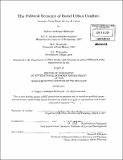The political economy of rural-urban conflict : lessons from West Africa & India
Author(s)
McDougal, Topher L. (Topher Leinberger)
DownloadFull printable version (15.59Mb)
Other Contributors
Massachusetts Institute of Technology. Dept. of Urban Studies and Planning.
Advisor
Balakrishnan Rajagopal.
Terms of use
Metadata
Show full item recordAbstract
This dissertation occupies the intersection between the fields of International Development, Political Economy, and Peace & Conflict Studies to examine how economic networks spanning the rural-urban divide condition conflict dynamics between an urban-based state and its rural-based challengers. In some cases of such violent internal conflict, the combat frontier is messy and erratic, as insurgents target cities as their economic prey. In other cases, the combat frontier is tidy and stable, seemingly representing an equilibrium in which cities are effectively protected from violent non-state actors. What accounts for these divergent outcomes? This question bears special importance in an era characterized by increasingly eroded capacity of states to exercise the famous Weberian monopoly on the use of coercive force. To explore this question, I did fieldwork in two regions representing these different outcomes. In West Africa (Liberia and Sierra Leone), capital cities became economic targets for rebels, who posed dire threats to the survival of the state. In Maoist India, despite an insurgent ideology aiming to overthrow the state via city capture, the combat frontier effectively firewalls cities from Maoist violence. I interviewed firm managers, traders, and, where possible, locals at risk for rebel recruitment. I employed formal modeling, and qualitative (semi-structured interviews, coding) and quantitative (multivariate and logistic regression) methods to analyze, first, the effects of violence on the structure of rural-urban trade networks, and second, the effects of trade network morphology on the structure of the combat frontier itself. I found that the trade networks that underpin the economic relationship between rural and urban areas may differ dramatically in their response to, and effect on, the combat frontier, depending on what type of underlying social structure they are based upon. Those based upon ranked, or hierarchical, social structures, were structured in such a way as to facilitate elite-elite trade deals between urban-based traders and rebel commanders that benefited the rural insurgents. By contrast, those based upon unranked, or egalitarian, social structures tended to disallow this sort of deal structure, concentrating profits in urban areas, destabilizing the combat frontier, and further incentivizing the targeting of cities. This study then seeks to recast dynamics of violent internal conflict as a dialectic relationship between intensification (production, often in state-controlled urban areas) and extensification (predation, often in rebel-held rural areas). It attempts to reconcile the opposing views that Development processes both drive and undermine violent conflict, and suggests that, in the absence of a monopoly on the use of coercive force, the state may benefit from geographic containment of competitive force by way of these "interstitial economies."
Description
Thesis (Ph. D. in International Economic Development)--Massachusetts Institute of Technology, Dept. of Urban Studies and Planning, 2011. "June 2011." Cataloged from PDF version of thesis. Includes bibliographical references (p. 139-146).
Date issued
2011Department
Massachusetts Institute of Technology. Department of Urban Studies and PlanningPublisher
Massachusetts Institute of Technology
Keywords
Urban Studies and Planning.